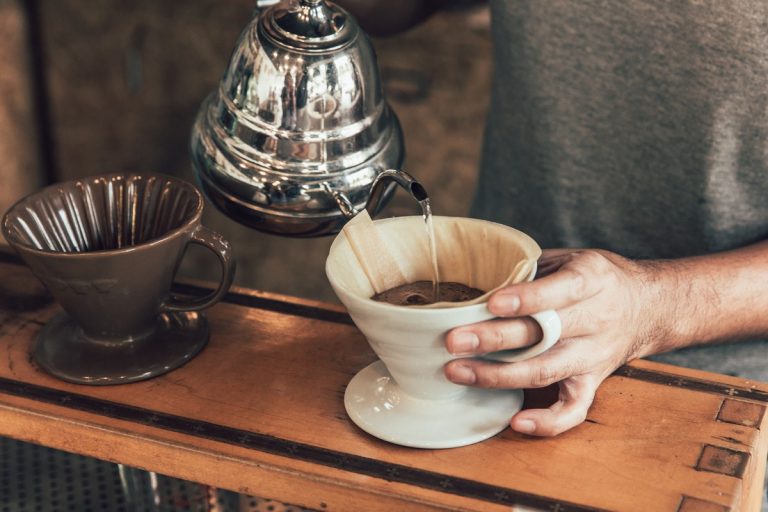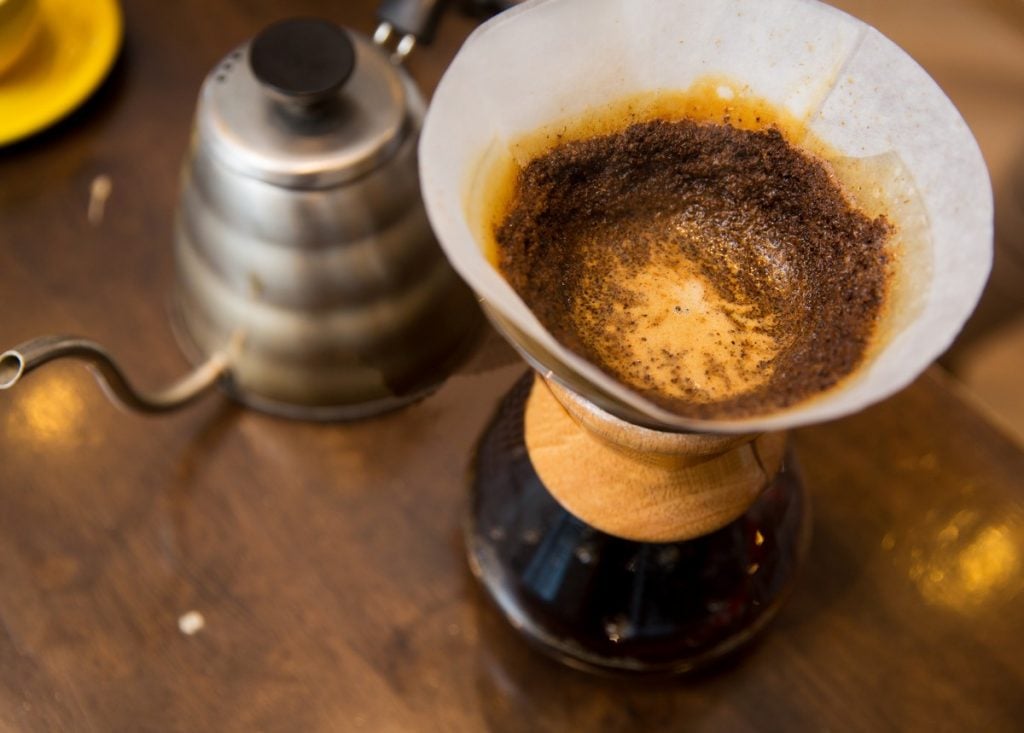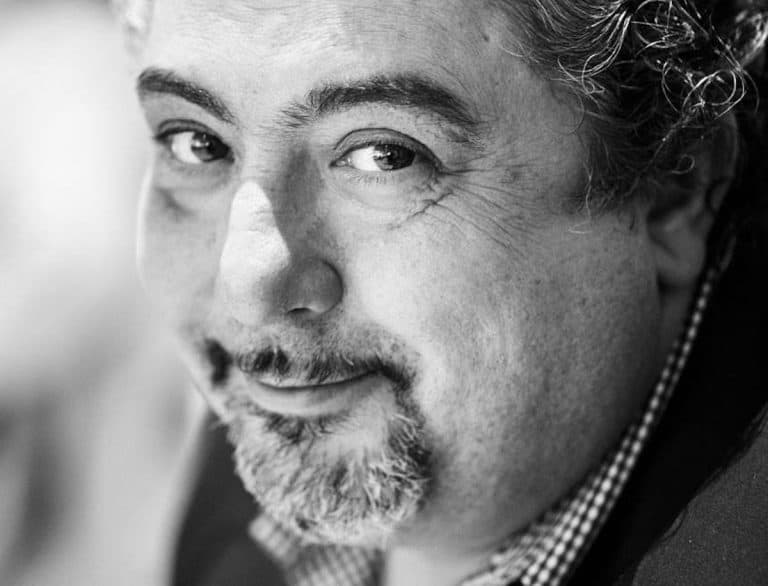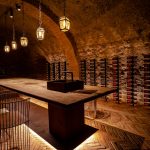Don't call it American: drip coffee is a more diluted drink, less consistent than an espresso, but very different from the "large coffee" so popular in the United States. The americano is indeed nothing more than an espresso – single or double shot – diluted with hot water, while drip coffee has a special extraction system, the result of a very precise technique and made with special tools.
V60: what drip coffee is
One of the most common and popular is prepared using the V60 method, named after the angle created by the filter. Other coffee brewing methods are aeropress, chemex, syphon and cold brew, a special drink made with cold water, perfect for those who do not want to give up coffee on hot days. But let's go back to the V60, the most popular brewing method among professional baristas who are passionate about specialty coffees, high-quality beans with greater aromatic complexity. It consists of two parts: the upper part, where the paper filter is positioned and the coffee extracted, and the lower part, where the dripper is assembled on top of a receptacle.
History of the V60: how drip coffee came about
The origin of the coffeemaker is generally traced back to 1908, when Melitta Bentz, a Dresden housewife, had the idea of using paper as filter for the first time (instead of the linen filter usually used at the time) to brew coffee. But that's not all: to extract it, she used a copper pot with holes on the bottom covered with paper towels. An early V60 prototype, patented at the Imperial Patent Office, that has evolved over time also thanks to the work of specialised companies such as Hario, which started out in 1921 as glass manufacturer and then embraced the coffee sector, creating the first syphon in the 1960s.
Drip coffee: how the V60 brewing method works
Very simple to use, V60 is a pour over method, which consists of extracting the beverage by pouring water directly onto the ground coffee bed. The filter is tucked in the cone, then freshly ground coffee is added, hot water is poured over it and left to percolate, letting through many complex aromatics.
V60: the advantages of drip coffee
But why is it the most popular method among baristas? "Its greatest advantage is its versatility," explains Alessandro Galtieri, Italian Brewers Cup champion – the craft of filter coffee brewing – and together with Cristina Caroli owner of the Aroma bar in Bologna, one of the best in the city. "It is convenient, easy to use, but above all it allows us to decide the type of drink we want to obtain". As we have already seen in the case of espresso preparation, it is difficult to establish a single recipe for a good drip coffee: there are so many variables to take into account, from the choice of beans to the one of water. And there are many ways to obtain a different result, even if you start from the same raw material: "Even if you speed up the pour, you can obtain a cup with different aromas and characteristics".
Tools for preparing a V60
A drink that can be brewed differently each time, easy to prepare at home as an alternative to the moka pot (the preparation lasts a bit longer, true, but its elegant taste is worth the wait). Coffee shops use very precise scales, kettles and timers, but for a homemade coffee you can use what you have at home: "Of course, you need the V60 Dripper, but you can use a classic electronic scale and the timer on your mobile phone". On the other hand, it would be advisable to invest a little more money in a professional kettle, featuring a specially shaped spout and a display of the current water temperature. But don't worry: "Stovetop kettles are a bit cheaper: in this case, you just need a thermometer to measure water temperature". The most popular brands are Hario and Bonvita, to purchase online or from retailers such as coffee shops and roasters.
How to brew drip coffee with the V60 method at home
Let's now come to the preparation. There are many variables, but Alessandro provides a "basic" procedure to follow in order to become familiar with the V60 method.
- Coffee ratio: for a simple recipe, we start with a standard quantity of 15 grams.
- Coffee grind size: always grind the beans fresh, preferable between 400 and 750 microns.
- Temperature and type of water: the water temperature should be between 194 and 205°F (90 and 96°C). It should be light but not completely demineralised, and the fixed residue should not be greater than 150 mg/L.
- Add the coffee: after wetting the filter slightly (it helps remove any starchy papery taste and warm the receptacle as well), remove the water from the receptacle and add the ground coffee to the filter.
- Blooming: this is the name given to the pre-infusion phase. Pour 30 millimetres of water (a ratio of 1:2) with circular movements and wait about 30 seconds.
- Extraction and brew ratio: the extraction is completed when the brew ratio is reached, i.e. the perfect ratio of ground coffee to water, here a total of 250 ml (normally it is used a coffee-to-water ratio of 60 grams per litre).
by Michela Becchi



 Farewell cacio e pepe in New York. "With tariffs, Pecorino Romano will also become more expensive." The warning from Giuseppe Di Martino
Farewell cacio e pepe in New York. "With tariffs, Pecorino Romano will also become more expensive." The warning from Giuseppe Di Martino Against tariffs? Here are the US foods that could be "hit"
Against tariffs? Here are the US foods that could be "hit" US tariffs: here are the Italian wines most at risk, from Pinot Grigio to Chianti Classico
US tariffs: here are the Italian wines most at risk, from Pinot Grigio to Chianti Classico "With U.S. tariffs, buffalo mozzarella will cost almost double. We're ruined." The outburst of an Italian chef in Miami
"With U.S. tariffs, buffalo mozzarella will cost almost double. We're ruined." The outburst of an Italian chef in Miami "With US tariffs, extremely high risk for Italian wine: strike deals with buyers immediately to absorb extra costs." UIV’s proposal
"With US tariffs, extremely high risk for Italian wine: strike deals with buyers immediately to absorb extra costs." UIV’s proposal







